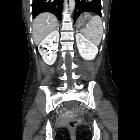Hepatic and splenic tuberculosis

Extrapulmonary
tuberculosıs: an old but resurgent problem. Abdominal CT scan and MR images of the same patient (in Fig. 27). Contrast-enhanced CT (a) and T1 weighted contrast-enhanced MR images (b) show a small abscess formation with rim-like enhancement in the anterior subcapsular region of the liver. Diffusion-weighted images (DWI) (c) and apparent diffusion coefficient (ADC) map (d) reveal diffusion restriction consistent with an abscess

Extrapulmonary
tuberculosıs: an old but resurgent problem. A coronal contrast-enhanced CT image of a 43-year-old male shows multiple hypodense lesions (arrows) in the liver and spleen. Hepatic and splenic TB

Hepatic and
splenic tuberculosis • Target sign in hepatic tuberculosis - Ganzer Fall bei Radiopaedia

Hepatic and
splenic tuberculosis • Mass-like hepatic tuberculomas - Ganzer Fall bei Radiopaedia

Hepatic and
splenic tuberculosis • Disseminated tuberculosis - Ganzer Fall bei Radiopaedia
Hepatic and splenic tuberculosis refers to tuberculosis affecting the liver and the spleen. It generally occurs due to haematogenous spread from the primary site of infection, commonly from pulmonary tuberculosis.
Pathology
Two types of lesions are known:
- micronodular (common)
- macronodular (rare)
Radiographic features
Ultrasound
Nonspecific features are usually seen, including hepatosplenomegaly and abscesses .
There may be small hypoechoic nodules (miliary type) or larger hypoechoic mass-like areas .
CT
- micronodular (miliary) type
- multiple
- small low attenuation areas with central enhancement (acute stage)
- calcification (chronic stage)
- macronodular type
- single or large tumor-like mass
- diffuse hepatosplenomegaly
MRI
- T1: lesions usually isointense when compared to the background parenchyma
- T2: mixed signal with hyperintense areas
- C+ (Gd): variable, reflecting the phases of the disease
Differential diagnosis
- for micronodular type
- lymphoma
- fungal infection
- metastases
- sarcoidosis
- for macronodular type
Siehe auch:

 Assoziationen und Differentialdiagnosen zu Tuberkulose von Leber und Milz:
Assoziationen und Differentialdiagnosen zu Tuberkulose von Leber und Milz:









